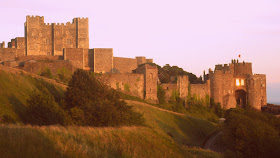 |
| Attribution: Ron Strutt, License |
Castle began to exist immediately before the
beginning of our era. Moat protecting the castle, was dug up in the prehistoric
Iron Age. After the arrival of the British Isles by the Romans in the 1st
century AD on the site
of the present town of Dover was founded a fortified
settlement. Dover began to develop as a Roman port. To do this, in 50 AD, two
lighthouses were built: one here and one in the Western Heights. Lighthouse,
located on the territory of the castle, has been preserved to this day. In the
Anglo-Saxon period, the lighthouse was attached to the church, and he began to
serve the bell tower.
In 1066, William I the Conqueror during the invasion of England took the castle. From that time until October 1958 the castle is always guarded by an armed garrison - i.e. for 892 years. May 22, 1216 Castle was besieged by Louis VIII. The siege lasted three months, but the lock got only minor damage. October 14, 1216, Louis VIII signed a truce and returned to London.
In 1066, William I the Conqueror during the invasion of England took the castle. From that time until October 1958 the castle is always guarded by an armed garrison - i.e. for 892 years. May 22, 1216 Castle was besieged by Louis VIII. The siege lasted three months, but the lock got only minor damage. October 14, 1216, Louis VIII signed a truce and returned to London.
| Name: Dover Castle
|
During the Middle Ages, the
castle served as border fortress facing the hostile lands of the Counts of
Flanders and the kings of France. Henry II gave to the castle concentric
defensive form that includes successive walls and towers. This was a novelty in
the fortifications, which had no parallel in Europe. In 1216, Dover successfully withstood a long
siege.
By 1250 his protective constructions have purchased the scale and forms
that shape current appearance of Dover Castle, which has always been a one of the
symbols of royal power.
In the 16th century, when the development of
artillery defensive importance of the castle began to decline and Dover upgraded.
During the XVII century, the English Revolution in 1642, the castle was in the
hands of supporters of the king, but was captured by deceit of of Parliamentarian without firing a shot. Mainly
because of this castle survived almost intact to the present.
During both world wars, fire arms of the castle
was upgraded. In 1939, during the Second World War, the tunnels were first
converted to the shelter, and then the command center and underground hospital.
In 1940, Admiral Bertram Ramsay managed the evacuation of British and French
troops from Dunkirk (Operation Dynamo) is from the underground tunnels at Dover
Castle.
 |
| Attribution: Webzooloo from France, License |
Nowadays Dover castle is a huge museum, which
attracts tourists from all over the world to experience the reign of the kings
of England. And also, to see another miracle of Dover, i.e., chalk cliffs are
visible for many miles from the open sea, their dazzling whiteness was the
first sign of approaching England for generations of sailors.
In the preparation of this article, were partially used materials of websites: www.wikipedia.org and www.caslall.ru.

Beautiful place! Going to visit the castle next year!
ReplyDelete